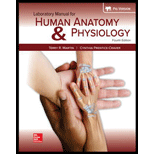
Concept explainers
Which of the following cellular structures is not easily visible with the compound light microscope?
- nucleus
- DNA
- cytoplasm
- plasma membrane
Introduction:
The biological microscope uses light to observe the cellular structures that are not visible by the naked eyes. It consists of two lenses: the eyepiece and the objective lens to form the image. The microscope uses visible light for the illumination of the object, and then the image is magnified by the lenses. The resolving power is 0.2µm and 1500x is the highest magnification of the light microscope.
Answer to Problem 1PL
Correct answer:
The correct answer is option (b) DNA.
Explanation of Solution
Explanation/justification for the correct answer:
Option (b) DNA. An electron microscope is used to observe the DNA molecule, which has a resolution of 0.2 nm, which makes it easier to observe the smaller units. In contrast, the typical light microscope is limited to the resolution of only 0.2 µm. Hence, it is not easy to observe the DNA molecule. So, the correct answer is option (b).
Explanation for incorrect answer:
Option (a) nucleus. The nucleus is the controller of the cell and is the darkly stained body that can be easily visible under a light microscope. So, this is an incorrect option.
Option (c) cytoplasm. The cytoplasm is observed under the light microscope, which is the part of the cell consisting of all the cell organelles. The cytoplasm can be easily identified in a stained cell. So, this is an incorrect option.
Option (d) plasma membrane. The plasma membrane is the covering of the cell that encloses all the living components of the cell. The membrane can be visualized by staining the cell. So, this is an incorrect option.
Want to see more full solutions like this?
Chapter 5 Solutions
Laboratory Manual For Human Anatomy & Physiology
- 18. Watch this short youtube video about SARS CoV-2 replication. SARS-CoV-2 Life Cycle (Summer 2020) - YouTube.19. What is the name of the receptor that SARS CoV-2 uses to enter cells? Which human cells express this receptor? 20. Name a few of the proteins that the SARS CoV-2 mRNA codes for. 21. What is the role of the golgi apparatus related to SARS CoV-2arrow_forwardState the five functions of Globular Proteins, and give an example of a protein for each function.arrow_forwardDiagram of check cell under low power and high powerarrow_forward
- a couple in which the father has the a blood type and the mother has the o blood type produce an offspring with the o blood type, how does this happen? how could two functionally O parents produce an offspring that has the a blood type?arrow_forwardWhat is the opening indicated by the pointer? (leaf x.s.) stomate guard cell lenticel intercellular space none of thesearrow_forwardIdentify the indicated tissue? (stem x.s.) parenchyma collenchyma sclerenchyma ○ xylem ○ phloem none of thesearrow_forward
- Where did this structure originate from? (Salix branch root) epidermis cortex endodermis pericycle vascular cylinderarrow_forwardIdentify the indicated tissue. (Tilia stem x.s.) parenchyma collenchyma sclerenchyma xylem phloem none of thesearrow_forwardIdentify the indicated structure. (Cucurbita stem l.s.) pit lenticel stomate tendril none of thesearrow_forward
- Identify the specific cell? (Zebrina leaf peel) vessel element sieve element companion cell tracheid guard cell subsidiary cell none of thesearrow_forwardWhat type of cells flank the opening on either side? (leaf x.s.) vessel elements sieve elements companion cells tracheids guard cells none of thesearrow_forwardWhat specific cell is indicated. (Cucurbita stem I.s.) vessel element sieve element O companion cell tracheid guard cell none of thesearrow_forward
 Human Biology (MindTap Course List)BiologyISBN:9781305112100Author:Cecie Starr, Beverly McMillanPublisher:Cengage Learning
Human Biology (MindTap Course List)BiologyISBN:9781305112100Author:Cecie Starr, Beverly McMillanPublisher:Cengage Learning Biology 2eBiologyISBN:9781947172517Author:Matthew Douglas, Jung Choi, Mary Ann ClarkPublisher:OpenStax
Biology 2eBiologyISBN:9781947172517Author:Matthew Douglas, Jung Choi, Mary Ann ClarkPublisher:OpenStax Concepts of BiologyBiologyISBN:9781938168116Author:Samantha Fowler, Rebecca Roush, James WisePublisher:OpenStax College
Concepts of BiologyBiologyISBN:9781938168116Author:Samantha Fowler, Rebecca Roush, James WisePublisher:OpenStax College Biology Today and Tomorrow without Physiology (Mi...BiologyISBN:9781305117396Author:Cecie Starr, Christine Evers, Lisa StarrPublisher:Cengage Learning
Biology Today and Tomorrow without Physiology (Mi...BiologyISBN:9781305117396Author:Cecie Starr, Christine Evers, Lisa StarrPublisher:Cengage Learning Human Heredity: Principles and Issues (MindTap Co...BiologyISBN:9781305251052Author:Michael CummingsPublisher:Cengage Learning
Human Heredity: Principles and Issues (MindTap Co...BiologyISBN:9781305251052Author:Michael CummingsPublisher:Cengage Learning





